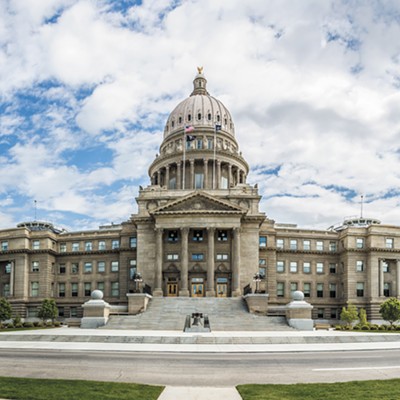Idaho's 105 legislators are back in their comfortable seats under the capitol dome in Boise, intent on carrying out the state's important and urgent business.
Well, maybe not so important. And maybe not so urgent. And maybe not even so comfortable.
This year, you see, is an election year, and concern for primary elections trumps most everything for the Republicans, who are in charge. For chomping at the bit back in the legislators' home districts are even more conservative candidates, eager to run against any RINO (Republican In Name Only) who shows a weakness for cooperating with the moderate middle in order to get things done.
As always, the most important and largest bill the legislature must pay will cover the cost of running Idaho's public schools. This responsibility is required to assure Idaho's 287,000 students are getting off to an educated start in life.
The schools have taken a hit ever since the Great Recession messed up the economy, big time. In his budget presented to this year's Legislature, Republican Governor Butch Otter suggested the Legislature restore $35 million to the public schools budget for the coming year. This number still falls $60 million short of 2009 expenditures, without allowing for inflation.
The Governor's recommendation doesn't signal that a crusade has been launched to improve Idaho's financial investment in its public schools: Idaho ranks 50th in the amount of money it pays to educate its children.
The public school appropriation is in the hands of the 20 members of JFAC, the Joint Finance and Appropriation Committee. But the public school appropriation bill is almost the last bill the Legislature acts upon in any session, which, even in an election year, is a couple of months down the legislative calendar.
Meanwhile, everybody agrees that Medicaid expansion will not even be debated in the 2014 legislative session, which will leave 100,000 or more Idahoans without health insurance. The state will walk away from $90 million in federal funds while keeping the wildly extravagant current indigent-care system in place at a cost of $60 million in state and county funds. This is inexcusable, irresponsible behavior on the part of the state's leaders. It's a no-brainer gone sour.
If the education budget is in JFAC's custody and Medicaid expansion is off the table, what hot topics will the legislators address? My prediction: Guns and wolves will attract a fair amount of attention.
According to the Fish and Game Department, Idaho now has around 680 wolves throughout the state. In 2009, wolf hunting became legal, and the governor announced he wanted to shoot the first one.
Idaho and its predators caught the attention of the New York Times this past December, when a planned coyote and wolf shoot-to-kill derby was scheduled in Salmon. Organizers offered $2,000 to the participants who killed the most animals. The event fell flat when no wolves and only 21 coyotes were bagged by the 230 registered contestants.
Not everyone is happy with Governor Otter's $2 million budget request to establish a special wolf control board, separate from the Department of Fish and Game. "Control" is another word for "kill." I, for one, would rather put the $2 million in the public school pot.
The Fish and Game Commission is already actively "controlling" wolves by hiring a lone gunman to eliminate wolves in the 2.37 million-acre Frank Church River of No Return Wilderness. The Idaho Conservation League has been remarkably tolerant on the wolf issue. But recently its Executive Director Rick Johnson asked, " If they can't live in the backcountry, where can they live?"
When 35 gray wolves were released in central Idaho in 1995, schoolchildren gave them names and followed their radio-relayed paths through the wilderness. As they thrived, their names disappeared and the wolves became numbers. As they multiplied, they became pests. Wolves, like coyotes, have always been pests to Idaho ranchers — and to the Idaho legislature.
It's refreshing to learn about Oregon's approach to a burgeoning wolf population. Oregon has developed a policy that calls for sheep and cattle outfits to use nonlethal methods to prevent wolves from snatching baby animals, especially lambs. These include simple measures such as keeping herds away from known wolf dens, employing loud noise alarms and scare devices, enlisting protective dogs and human herders, constructing barriers and building fences. Such items add costs but also avoid conflicts.
Consumers could be wooed to pay a little bit more for lambs raised in a certified, nonlethal-to-wolves environment.
The questions the reintroduction of wolves into Idaho has presented are worth pondering. Do we believe game hunting should include animals that we don't plan to eat? Is there room in our hearts, minds and geographical space for predators other than our own species? If so, are we willing to cover their costs? ♦
The original version of this column misstated the size of the Frank Church River of No Return Wilderness. It encompasses 2,366,757 acres.





















